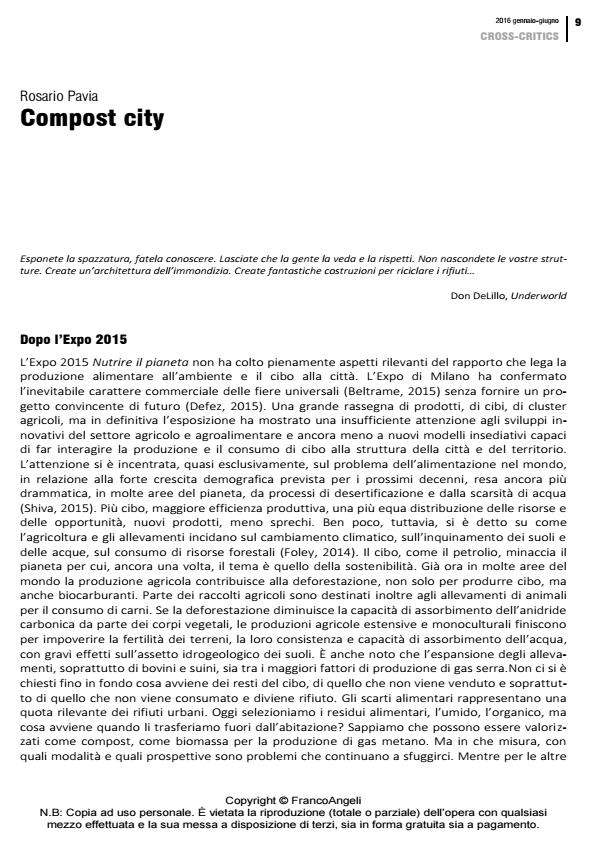Compost city
Journal title CRIOS
Author/s Rosario Pavia
Publishing Year 2016 Issue 2016/11 Language Italian
Pages 12 P. 9-20 File size 1065 KB
DOI 10.3280/CRIOS2016-011002
DOI is like a bar code for intellectual property: to have more infomation
click here
Below, you can see the article first page
If you want to buy this article in PDF format, you can do it, following the instructions to buy download credits

FrancoAngeli is member of Publishers International Linking Association, Inc (PILA), a not-for-profit association which run the CrossRef service enabling links to and from online scholarly content.
Starting from a critique to Milan Expo 2015, the paper argues that food, urban agriculture and organic waste recycling are all issues to be included into urban policies and plans. Urban metabolism calls for a new hygienic turn of planning, from infrastructure to reclamation, and requires holistic and long term strategies while focusing on adaptive processes to handle present challenges. Waste is a major issue to rethink the city of the future, the compost city, revolving around a soil project aiming at the constant regeneration and connection of organic and mineral components of the urban environment.
- AA.VV. (2015). Nutrire l’impero Storie dell’alimentazione da Roma a Pompei. Roma: L’Erma di Bertschneider.
- Beltrame M. (2015). Expo Milano 2015. Storia delle esposizioni universali. Milano: Meravigli.
- Branzi A. (2006). Modernità debole e diffusa: il mondo del progetto all’inizio del XXI secolo. Milano: Skira.
- Braungart M., Mc Donough W. (2002). Cradle to cradle. Remaking the way we make things. New York: North Point Press.
- Calvino I. (1972). Le città invisibili. Torino: Einaudi.
- Caravaggi L. (2012). Paesaggi commestibili nella campagna romana. Piano Progetto Città, 25-26.
- Cattivelli V. (2014). L’esperienza degli orti urbani nel comune di Milano. Agriregionieuropa, 39, 129-143.
- Choay F. (1973). La città. Utopie e realtà. Vol. 1. Torino: Einaudi (ed. orig. 1965).
- Clement G. (2008). Il giardiniere planetario. Milano: Publishing (ed. orig. 2004).
- Defez R. (2015). Un’altra Expo con Strampelli. Il Sole 24 ore. 29 Novembre.
- Donadieu P. (2006). Campagne urbane. Una nuova proposta di paesaggio della città. Roma: Donzelli (ed. orig. 1988).
- FAO (2001). Urban and peri-urban agriculture. A briefing guide for the successful implementation of Urban and Peri-urban Agriculture in Developing Countries and Countries of Transition, Rome: Food and Agriculture Organization of The United Nations.
- Farinella R. (2009). Le Grand Paris. Invenzione di una metropoli in cerca di governo. Paesaggio Urbano, 4, 70-93.
- Foley J. (2014). Cinque azioni per nutrire il mondo. National Geographic Italia, Maggio.
- Gasparrini C. (2014). In the City On the Cities. Trento: LISt Lab.
- Giacchè G., Tóth A. (2013). COST Action Urban Agriculture Europe: UA in Barcelona Metropoltan Region Short Term Scientific Mission Report. Barcelona: Universitat Politecnica de Catalunya.
- Jansa J. E., Visser A.J. (2011). Agromere: integrating urban agriculture in the development of the city of Almere. AU Magazine, 25, 28-31.
- Landolfo P., Musmeci F. (2013). Il compostaggio di comunità. In: Energia, Ambiente e Innovazione. Settembre-Ottobre, 95-101.
- Legambiente (2014). Comuni ricicloni. Rifiuti oggi, anno 24, 1.
- Logan B. L. (2011). La pelle del pianeta. Storia della terra che calpestiamo. Torino: Bollati Boringhieri (ed. orig. 1995).
- MacLean A. (2012). Up on the roof: NewYork’s hidden skyline spaces. New York: Princeton
- Architectural Press.
- Mairie de Paris (2011). Plan Biodiversitè, Programmed’actions pour préserver et enrichir la biodiverstè a Paris. Paris.
- Miller M.J. (2014). A farm grows in Brooklyn on the Roof. National Geographic, 29.
- Mininni M. (2011). La sfida del piano paesaggistico per una nuova idea di sviluppo sostenibile. Urbanistica, 147, 7-71.
- Montanari M. (2006). La fame e l’abbondanza. Storie dell’alimentazione in Europa. Bari: Laterza.
- Nomisma (2012). Il fenomeno dell’hobby farming in Italia: i risultati del II° Rapporto Nomisma - Vita in campagna. Montichiari: Nomisma.
- Parham S. (2015). Food and urbanism. The convivial city and a sustainable future, London: Bloomsbury Accademic.
- Pinna L. (2011). Autoritratto dell’immondizia. Come la civiltà è stata condizionata dai rifiuti. Torino: Bollati Boringhieri.
- Shiva V. (2015). Chi nutrirà il mondo? Manifesto per il cibo del terzo millennio. Milano: Feltrinelli.
- Smit J., Nasr J. (1992). Urban agriculture for sustainable cities: using wastes and idle land and water bodies as resources. Environment and Urbanization, 4(2), 141-152.
- Sommariva E. (2015). Creating city. Agricoltura urbana strategie per la città resiliente. Trento: LISt Lab.
- Sori E. (1999). Il rovescio della produzione. I rifiuti in età pre-industriale e paleolitica. Bologna: Il Mulino.
- Circular wastescapes. Waste as a resource for periurban landscapes planning Libera Amenta, Anna Attademo, in CRIOS 12/2016 pp.79
DOI: 10.3280/CRIOS2016-012008 - The Valuation of Idle Real Estate in Rural Areas: Analysis and Territorial Strategies Anna Richiedei, in Sustainability /2020 pp.8240
DOI: 10.3390/su12198240
Rosario Pavia, Compost city in "CRIOS" 11/2016, pp 9-20, DOI: 10.3280/CRIOS2016-011002